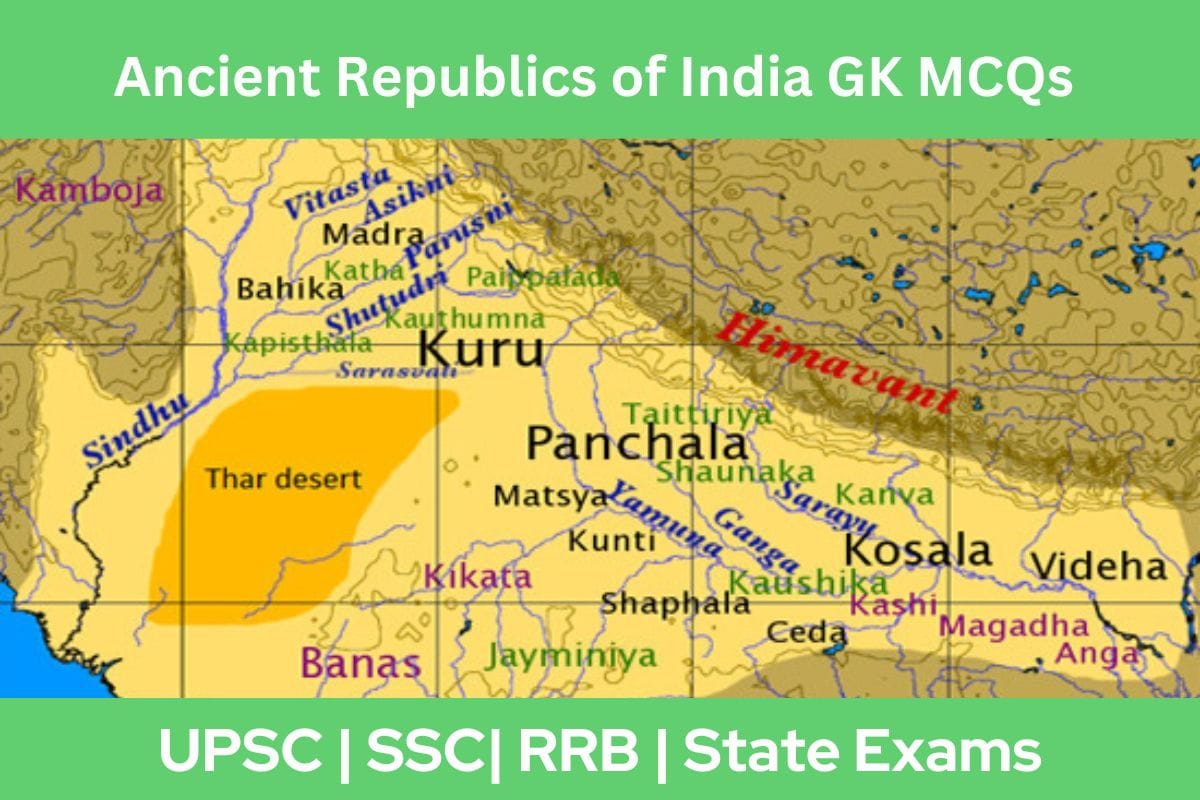
Welcome to a comprehensive overview of the Ancient Republics of India! This set of 10 Multiple Choice Questions (MCQs) has been tailored to assist you in your preparation for various government job comparative exams. Each question is accompanied by a detailed explanation to enhance your understanding of the historical governance structures in ancient India.
MCQs with Answers and Explanations:
1. What was the name given to the republican states in ancient India that had a federal character?
- Kingdoms
- Nigamas
- Janapadas
- Sangha
Show Answer
Correct Answer: Janapadas
The republics in ancient India were categorized into two main types: pure republics and Kshatriya aristocracies. Pure republics were characterized by a more democratic and decentralized political structure, while Kshatriya aristocracies were dominated by warrior or noble classes. The republics with a federal character were known as Janapadas or state-republics. These Janapadas had a federal constitution and a more centralized administration. They were typically larger in scale and often controlled a group of smaller republican states.
2. In the 6th century BCE, the republican state of Sakya was ultimately occupied by which clan?
- The state of Maurya
- The state of Vajji
- The state of Kosala
- The state of Gandhar
Show Answer
Correct Answer: The state of Kosala
The Sakya clan of Kapilavastu was indeed an important republican state in ancient India. Mahatma Buddha, the founder of Buddhism, belonged to the Sakya clan. The Sakya republic was located near the border with Nepal. It had a federal constitution that allowed for a degree of self-governance within the region. However, the state of Kosala ultimately occupied Sakya near the end of the 6th century BCE, leading to the decline of the Sakya republic.
3. Which was the largest and most powerful republican state in ancient India?
- The Mallas of Pava.
- The Lichchavis of Vaisali.
- The Sakyas of Kapilavastu
- The Mallas of Kushinara.
Show Answer
Correct Answer: The Lichchavis of Vaisali.
The Lichchavis of Vaisali was one of the most prominent republican states in ancient India. It was a pure republic with a democratic system of governance. The Lichchavis extended their influence and controlled a confederation of republican states, including nine Mallas and eighteen Kasi and Kosala republics. Vaisali, the capital of the Lichchavis, became a significant center of early Buddhist activity.
4. Which of the following statements about the Sakyas clan is correct?
- It was situated near the border of Nepal.
- Mahatma Buddha’s mother belonged to this clan.
- It had a unitary constitution.
- The capital of Sakya was Kapilavastu.
Show Answer
Correct Answer: It was situated near the border of Nepal.
The republican state of Sakya was located near the Nepal border. Mahatma Buddha belonged to the Sakya clan. The republican state of the Sakyas had a federal constitution, and its capital was Kapilavastu.
5. Which ruler was successful in annexing the Lichchavis of Vaisali?
- Ashoka
- Ajatshatru
- Kalasoka
- Chandragupta Maurya
Show Answer
Correct Answer: Ajatshatru’
Ajatshatru, the ruler of the powerful state of Magadha, was indeed successful in annexing the Lichchavis of Vaisali. Ajatshatru pursued this annexation with a combination of military preparations and diplomatic relations. His consolidation of the Lichchavi republic contributed to the expansion of the Magadha Empire.
6. Where was the capital of the state of Koliya situated?
- Sun Samagri
- Kusinara
- Ramagrama
- Vaisali
Show Answer
Correct Answer: Ramagrama
The republican state of Koliya was situated to the east of the state of Sakyas. The capital of Koliya was located in Ramagrama. The conflict between these two states over the use of the Rohini River’s water resources is mentioned in Buddhist texts and reflects the historical rivalries that sometimes existed among these ancient Indian republics.
7. Which dynasty destroyed the republican states of Ancient India?
- Mauryan Empire
- Gupta Empire
- The Pallavas
- Indo-Greeks
Show Answer
Correct Answer: Gupta Empire
The republican states of Ancient India were destroyed by the Gupta Empire. The Gupta rulers pursued a policy of expansion and annexed many neighboring states, including the republican states.
8. Where was the capital of the state of Mallas situated?
- Ramagrama
- Pava
- Suputa
- Mithila
Show Answer
Correct Answer: Pava
The capital of the republican state of Mallas, a Kshatriya republic, was situated in Pava. This city was visited by Buddha during his last journey.
9. What is the significance of the term “Mahajanapadas” in ancient Indian history?
- Religious texts
- Great empires
- Republics and city-states
- Trade routes
Show Answer
Correct Answer: Republics and city-states
Mahajanapadas referred to powerful republics and city-states that played a crucial role in ancient Indian political and social dynamics.
10. Which ancient Indian republic is known for its emphasis on democracy and the assembly of citizens known as the “Sabha”?
- Vajji
- Magadha
- Kosala
- Kuru
Show Answer
Correct Answer: Vajji
Vajji, specifically the Licchavi clan, is renowned for its democratic governance structure, with the Sabha serving as the assembly of citizens.
Republics in ancient India Notes for UPSC Exam



